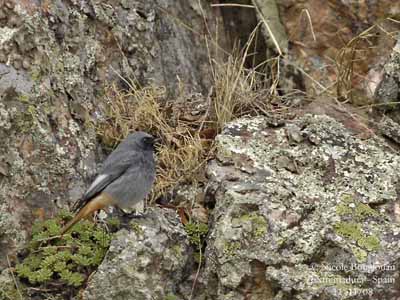
Black Redstart
Phoenicurus ochruros
Passeriforme Order – Muscicapidae Family
BIOMETRICS:
Length : 14-15 cm
Weight : 14-20 g
LONGEVITY: Up to 8 years
DESCRIPTION:
Black Redstart is a species living mainly in rocky places, but also on buildings and monuments in villages and towns.
Fr : Rouge-queue noir
All : Hausrotschwanz
Esp : Colirrojo Tizón
Ital: Codirosso spazzacamino
Nd: Zwarte Roodstaart
Sd: Svart rödsjärt
Photograph by Jean Michel Peers (female with prey)
JMPN PHOTOGRAPHIE
Photographs and text by Nicole Bouglouan
Sources :
HANDBOOK OF THE BIRDS OF THE WORLD Vol 10 by Josep del Hoyo-Andrew Elliott-David Christie - Lynx Edicions - ISBN: 8487334725
THE HANDBOOK OF BIRD IDENTIFICATION FOR EUROPE AND THE WESTERN PALEARCTIC by Mark Beaman, Steve Madge - C.Helm - ISBN: 0713639601
THE COMPLETE BOOK OF BRITISH BIRDS – Written by “Royal Society for the Protection of Birds” experts - Préface de Magnus Magnusson - Michael Cady- Rob Hume Editors - ISBN: 0749509112
Pájaros de España (JL Beamonte)

Adult male has slaty-grey plumage on the upperparts, including on the crown, with darker tinge on the wings. Flight feathers are dark grey to blackish with white edges, forming white patch when wings are closed. Rump is red-orange. Central uppertail feathers are blackish with red-orange outer rectrices.
On the underparts, face, throat and breast are blackish. Belly and flanks are slaty-grey. Lower belly and undertail feathers are red-orange.
The slender bill is surrounded by conspicuous rectal bristles. Bill, eyes, legs and feet are black.
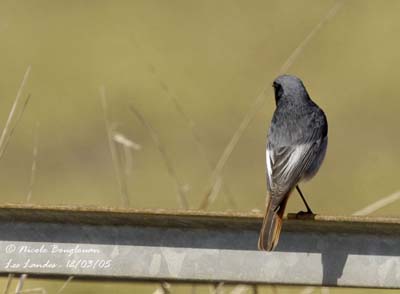
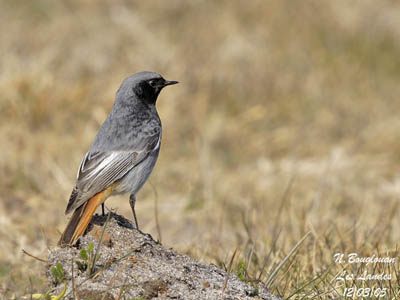
Female is smoky grey-brown overall, with darker brown wings.
The underparts are slightly paler. Rump, vent, undertail feathers and outer rectrices are orange-red, but duller than in male.
On the head, cheeks and ear-coverts are browner than body.
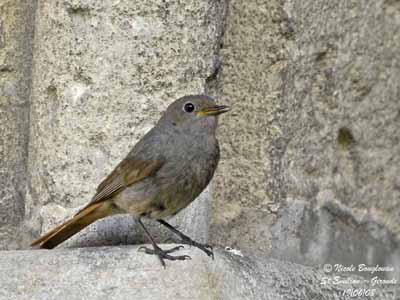
The juvenile resembles female, but it is slightly darker on upperparts and underparts. Throat and breast show weak scaling.
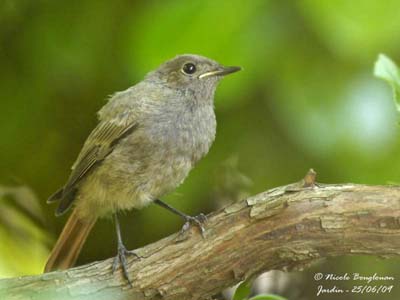
We can find several subspecies, according to the range. They differ in red-orange extension on the underparts, with more or less dark upperparts.
P.o. gibraltariensis, P.o. ochruros, P.o. semirufus, P.o. phoenicuroides and P.o. rufiventris share the wide range from W Europe and NW Africa, to China.
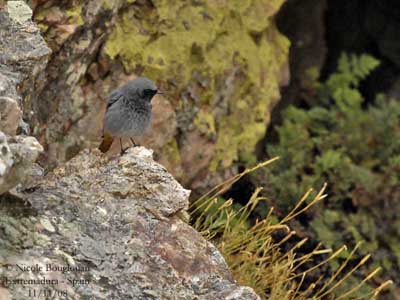
VOICE:
Black Redstart utters sharp” tsip”, sometimes in series “tsip-tsip-tsip”, as contact or alarm call. In territorial defence, it gives hard “tuc”. When the bird is really threatened, it utters both sounds “tsip-tk-tk”.
During courtship displays and fights, it gives short whistles and churrs.
The song is variable with some mimicry, composed with weak warbling phrases, often beginning with the “tsip” note, followed by rolling “truee-truee-truee”.
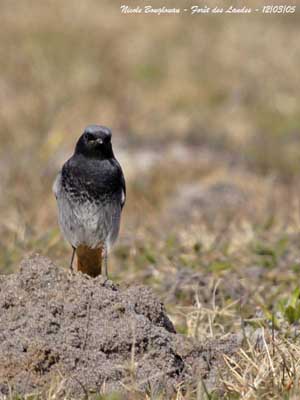
HABITAT:
Black Redstart frequents rocky areas with some vegetation, stony slopes, crags and gulleys in mountainous areas.
This species is also found near humans in villages and towns, preferring buildings and monuments rather than parks and gardens.
According to the range, each subspecies is adapted to the local habitat.
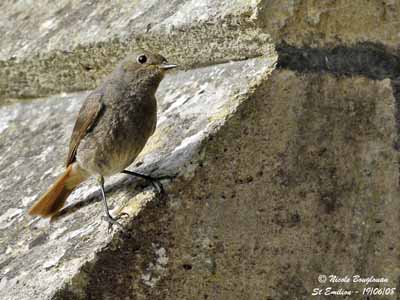
RANGE:
Black Redstart breeds in S and C Europe, and locally in Great Britain.
It is resident in most part of the range, but the northern populations winter in the southern parts of the range.
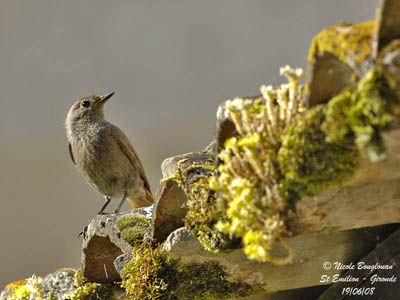
BEHAVIOUR:
Black Redstart perches among the vegetation in trees and bushes. It is often seen in upright stance with quivering tail. It drops to feed on the ground where it hops while searching for preys. It uses the “sit-and-wait” tactics.
This bird feeds mainly on invertebrates and berries. It consumes various insects, spiders, small molluscs and earth worms. Fruits and seeds of several plant species are taken too.
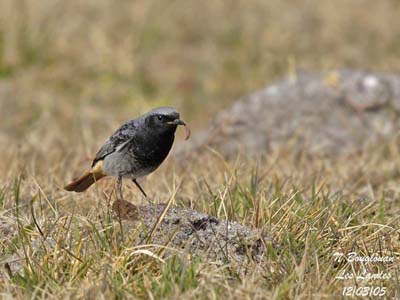
During the breeding season, the male sings according to the different situations. It sings when arriving on breeding areas and to establish the territory. It also sings to attract a female and until the beginning of the nest building. The male selects the nest-site, but the nest is built by the female. At this moment, the male is rather silent until the egg-laying. It sings again during the incubation until the hatching of the chicks. Then, it becomes silent again until the young are independent.
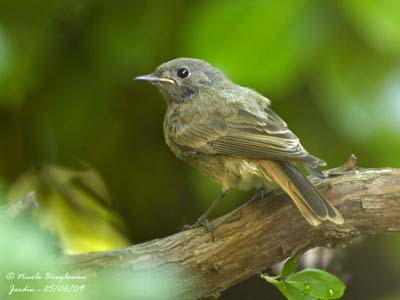
The Black Redstart is always moving. It gives short calls when threatened or excited, while it crouches and flicks its tail. Intruders are chased away from the territory, including those of its own species.
Courtship displays include “dances” before the copulation.
Black Redstart is partially migratory, resident or full migratory according to the range. Some species only performs altitudinal movements whereas others migrate.
VOL:
Black Redstart performs rapid, powerful flight. It is able to perform flycatching to capture insects.
This bird shivers or flickers the tail, mainly after landing.
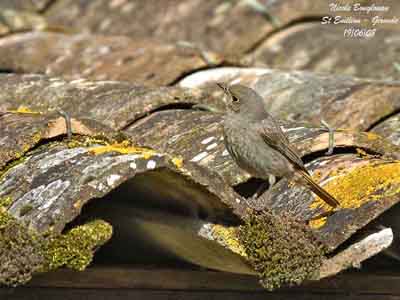
REPRODUCTION:
Breeding season varies according to the range.
Black Redstart nests in holes and cavities such as crevices in rocks and walls, in earth banks or piles of stones, sometimes on the ground. The nest is cup-shaped. It is made with grass, moss, hair and feathers.
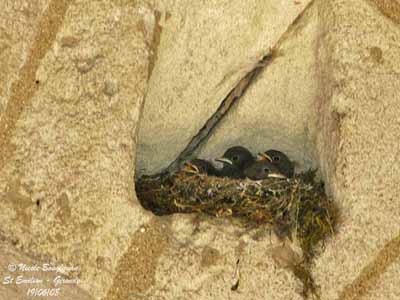
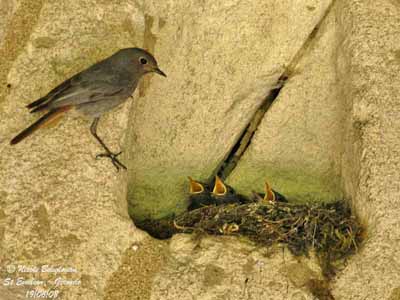
Female lays 4 to 6 white eggs. Incubation lasts 12-13 days, by female alone. The young leave the nest about 12 to 17 days after hatching, but they cannot fly during several days, and they remain in the surroundings of the nest. They are fed by both adults, mainly on insects.
This species produces two broods per year.
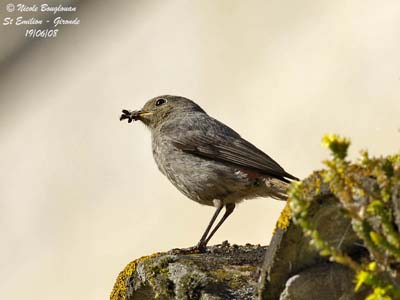
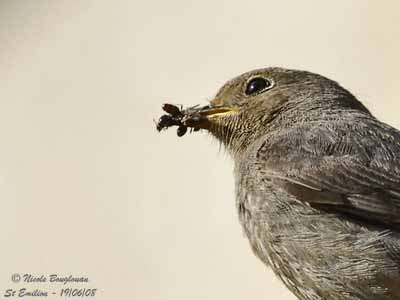
DIET:
Black Redstart feeds mainly on invertebrates such as grasshoppers, bugs, lepidopteran insects, flies, ants, bees, wasps, beetles, spiders, small molluscs and earth worms.
It also feeds on berries, fruits and seeds. The diet may vary according to the location.
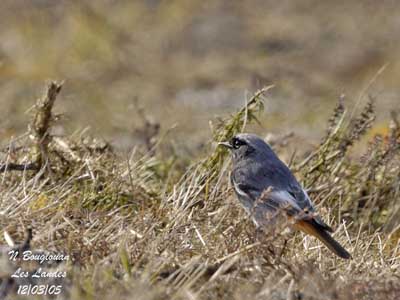
PROTECTION/ THREATS/STATUS:
Black Redstart is relatively common within the range.
This species is not globally threatened at this moment.